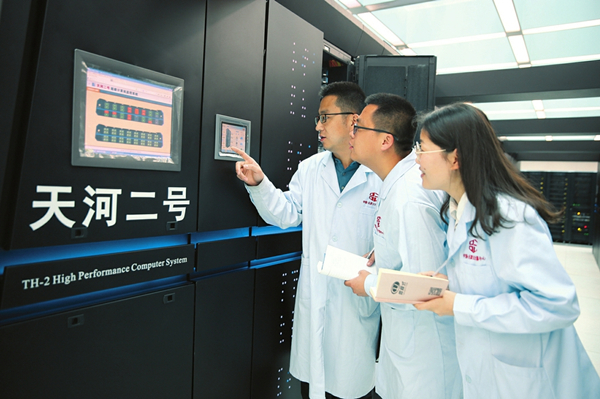University's computing center marks its first decade
Updated: 2022-05-27

Engineers check the Tianhe-2 supercomputer at the Lyuliang High-Tech Development Research Academy. [Photo by Yan Zhongxing for China Daily]
When the renowned National University of Defense Technology, which is based in Changsha in Central China's Hunan province, was deciding whether to build a supercomputing center in Shanxi, it beat the expectation of many that Lyuliang, a city in the mountainous region in the west of the province, was chosen as the locale.
After 10 years operation, the center, which is called Lyuliang High-Tech Development Research Academy, has proved to be a success.
When representatives of the NUDT were signing the agreement for the center with the city government of Lyuliang 10 years ago, they said the city's climate featuring an annual average temperature of 9 C, and its steady electricity supply from local coal-fired power plants and solar farms, as well as the strong demand from Shanxi's manufacturing enterprises for digital transformation were key factors in the university's decision.
Over the past decade, the center, based on its powerful Tianhe-2 supercomputer, has developed into the most important supercomputing center in Shanxi, offering services to more than 1,800 enterprises, research institutions, universities and other entities in the province and beyond.
When talking about how the center works, Wang Lian, an engineer at the center's operational hub, described the surprisingly powerful performance of the Tianhe-2 with an easy equation. "The computation of the Tianhe-2 in an hour can be completed by 1.3 billion people over 104 years using calculators."
Over the past decade, the supercomputing center has offered services to enterprises in fields including coal mining, new energy, new materials, life sciences, artificial intelligence and nonferrous metals by helping them build big data and cloud computing platforms.
It has made a special contribution to the coal-mining and related industries by helping companies develop digital and smart manufacturing solutions.
One example is its collaboration with the coal-based chemicals research institute of the Chinese Academy of Sciences since 2014. Its analog simulation system based on high-performance computing helped the institute develop a globally leading catalytic agent for coal liquefaction.
The supercomputing center has also helped the city of Lyuliang develop its e-government project, greatly improving its efficiency in many administrative areas like government services, social governance and production safety management.
Hou Guangyu, president of Lyuliang High-Tech Development Research Academy, said while helping the local government improve its administration efficiency through digitalization, the supercomputing center also aims to create a talent pool for local development by training more high-tech professionals.
"A strong force of high-tech professionals is crucial for transforming Lyuliang from a coal-mining city to a 'data-mining' hub," Hou said.
Guo Yanjie contributed to this story.



